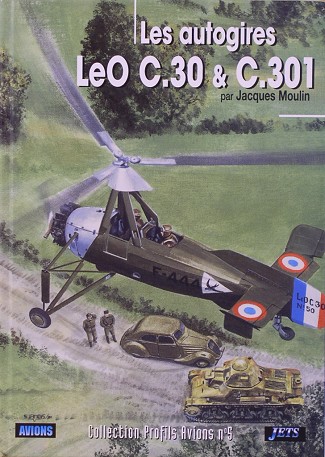 Characteristics:
Characteristics:
|
Title: |
Les Autogires LeO C.30 & C.301 |
|
Authors: |
Jacques Moulin |
|
Publisher |
LELA PRESSE |
|
Price |
Approx 45 $ USD + p&p |
|
Reviewer: |
|
|
Notes: |
ISBN 9782914017152 |
 Characteristics:
Characteristics:
A-4 format, hard cover, 256 pages, 325 pictures in b/w, 3 color restored pictures, 5 drawings, 27 color profiles, 3D cutaway.French text.
As everybody knows, wing and speed are the two factors, which added, allow the flight. Juan de la Cierva who tried to find the way to reduce the take off length and stall speed after the death of its test chief imagined the “autogire” concept in 1923, when he replaced the wing with a rotor. An amazing concept for the date, a funny mixture of standard aircraft with front conventional engine and “something” hooked above. From the C1 to the C55, more than 55 evolution types have been design with the main well known C30. The autogires around the world are based on the same design in USSR and in USA( Pitcain and Kellet). French authorities saw the advantages of such capabilities for they armies as observer and artillery pointer. In 1930 the French navy turned to the C30 via Lioré et Olivier home manufacturer. La Cierva himself displayed its hybrid aircraft in front of military and civil staffs. Here start the adventure! This very complete heavy book is divided in 22 chapters:
1- history and rules of flight of the autogire
2- first French autogire
3- C30A in foreign Air Forces
4- LeO C.30 (technical)
5- Units (autogire sections, GAR, Groupe d’Aviation Regional (Region Aviation Group)
6- Training Schools (Etampes, Salon, Sommesous)
7- French Air Force (on 3 september 1939, on battefield, the survivors after the battle)
8- German occupied period
9- The French Navy autogires
10- The derivatives SNCASE C.301/302
11- The prototypes (C.301/302, Avro C30A, postal type..)
12- camouflage and markings
13- conclusion
14- individual career of “aircrafts”
15- accident listing
16- Appendix: notices on reception, trials, accidents..
17- Individual experiences
18- Bibliography
19- Drawings
20- Cutaways (2)
21- Profiles
As you can see, its very
detailed and the numerous quality pictures cover well the rare subject.
I appreciate the large format printings from the original technical notice which
uncover all the parts (airframe, engine, rotor, cockpit…). The large 3D drawings
resume the intricate machine, and the very good color profiles show the blue/gray
French Navy machines, 3 tone, and kaki Armée de l’Air, and amazingly silver
Swedish, Danish, English, and Spanish machines. Finally the blitzkrieg on West
swept and reduced allied Air Force in two months, and the Autogire were added to
the long list, “escape as you can, in order” was rather the order. Good b/w “in
action” pictures illustrate the volume. (in flight and on ground , spectacular
“up side down”, which in fact was due to delicate flying rules for this special
machine).
Being Pioneer in aviation was not without risk, and this book brings the proof.
Is this rotorcraft style disappear? NO! Just see for example at : http://www.pra.org/
And you’ll discover that modern free civil pilots keep in 2006 this spirit alive.
I recommend this book also for modellers who would like to model the JMGT or Andrea Miniature 1/48 scale La Cierva autogire, or their US cousin PITCAIRN AUTOGIRO by Williams Brothers.
January 2006
Available at: http://www.avionsbateaux.com/
If you would like your product reviewed fairly and quickly by a site that has over 300,000 visitors a month, please contact me or see other details in the Note to Contributors.